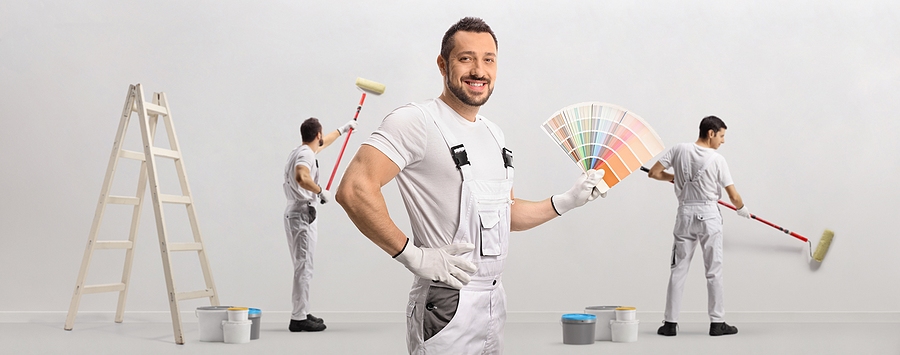
Seamless Blends: How Professionals Achieve Perfectly Painted Textured Walls
Textured walls, with their unique and aesthetically pleasing surfaces, can be a focal point in any room. They offer a visual and tactile element that flat walls simply cannot provide. But when it comes to painting textured walls, achieving a seamless and polished look requires a certain finesse and expertise. In this article, we delve into how professional house painters ensure that your textured walls are painted to perfection.
The Allure of Textured Walls
Textured walls carry a certain charm and elegance that can enhance the architectural integrity of a room. They can hide imperfections, add depth, and provide a tactile dimension to an othprerwise flat surface. However, to maintain and elevate their aesthetic appeal, the painting needs to be executed meticulously, ensuring that every groove, bump, and nuance of texture is highlighted without being overpowering.
Textured walls come in various forms and styles, each carrying its own unique charm and set of requirements when it comes to painting and maintenance.
The Tapestry of Textures
1. Popcorn Texture: Characterized by its bumpy surface, popcorn texture is often found on ceilings but can also be utilized on walls to add a compelling tactile element. Painting over a popcorn texture usually demands a thicker nap roller to navigate the textured peaks and ensure even paint distribution.
2. Knockdown Texture: This texture resembles stucco and provides a more subtle aesthetic than the popcorn texture. It involves applying joint compound (also known as mud) and smoothing it down with a trowel in a subtle, yet textured, pattern. Due to its slightly flattened appearance, it can be easier to paint than more dramatically textured walls, yet still requires attention to detail to ensure the grooves are adequately covered.
3. Orange Peel Texture: Mimicking the peel of an orange, this subtle, yet engaging texture adds a delicate and nuanced visual appeal to walls. Despite its slight texture, the small bumps can be tricky to paint over evenly, and thus professionals often utilize specific rollers and techniques to ensure an even application.
4. Skip Trowel Texture: Offering a Mediterranean feel, skip trowel texture is created using a trowel to apply thin layers of drywall compound, forming an artistic, abstract pattern. It demands a strategic approach to painting to ensure that the textured details are preserved and highlighted, rather than drowned in paint.

Unveiling Aesthetic Impacts
The visual impact of textured walls can vary greatly, shaping the atmosphere of the room significantly. A popcorn texture might provide a cozy and classic feel, while a skip trowel texture could lend a rustic and vintage ambiance to the space. The way light interacts with these textures, creating shadows and highlights, plays a pivotal role in bringing walls to life, transforming them from mere boundaries to dynamic visual elements of interior design.
Special Requirements and Preservation
Each textured wall type brings forth its own set of requirements and challenges when it comes to preservation and painting:
- Strategic Painting: Given their varied and uneven surfaces, textured walls generally demand a more strategic approach to painting. Areas with deeper grooves or more pronounced texture may require additional layers of paint or a specific application technique.
- Cleaning Challenges: Textured walls, due to their uneven surfaces, can be a bit more challenging to clean as dust and cobwebs tend to settle in the nooks and crannies. Certain textures might require soft brushing prior to any wet cleaning to preserve the integrity of the wall.
- Repair Considerations: Repairing any damages or cracks in textured walls may also involve recreating the texture, which can be a delicate and intricate task to ensure consistency across the wall.
Textured walls, while providing an exquisite aesthetic, demand a nuanced approach in terms of painting, cleaning, and maintenance to preserve their visual and tactile allure. Ensuring that these walls are treated with the requisite care and attention, especially when it comes to painting, will maintain their unique appeal and ensure they remain a focal point of your living space for years to come.

The Professional Touch: Preparing the Surface
A crucial step in achieving a seamlessly painted textured wall lies in thorough preparation. Professional painters understand that the uneven surface requires special attention to ensure that paint adheres uniformly across the varied texture. They will:
- Inspect and Repair: Ensure that there are no cracks, peeling, or damage to the texture that needs addressing before painting.
- Clean Thoroughly: Remove any dust, dirt, or cobwebs from the texture using brushes and cleaning solutions, ensuring a smooth and clean surface for painting.
- Primer Application: Apply a high-quality primer to ensure that the paint adheres properly and that the colors show up vibrantly against the texture.
Precision in Painting: Techniques and Tools
Professional painters employ a plethora of techniques and use specific tools to ensure that the textured walls are painted seamlessly.
- Rollers over Brushes: Rollers, especially those designed for textured surfaces, can navigate the nooks and crannies of textured walls much better than brushes.
- Layering Paint: Applying thin, multiple layers of paint instead of a single, thick layer ensures that the paint seeps into every crevice of the texture without dripping or pooling.
- Drying Time: Allowing sufficient time for each layer to dry before applying the next is crucial to prevent smudging and to maintain consistency.
Expertly painting textured walls involves employing specialized techniques and tools to navigate the irregularities of the surface and produce an evenly coated, appealing result. Professional painters bring to the table a wealth of experience and mastery of specific methods that allow them to achieve a flawless finish on various textured surfaces.

Navigating the Peaks and Valleys
Textured walls inherently possess a landscape that features varying degrees of peaks and valleys which conventional painting methods might struggle to effectively cover. Here’s where pros utilize a method known as “stippling,” where instead of a typical rolling action, the paint is dabbed onto the wall, ensuring every nook and cranny receives adequate coverage.
Employing the Right Tools
Professionals often choose a roller with a thicker nap to traverse the textured terrain of the wall adequately. The increased thickness allows the roller to navigate the uneven surface, ensuring that the paint adequately fills in the textures without leaving bare spots.
Employing a Primer Coat
Application of a primer can be a pivotal step when working with textured walls. Not only does a primer help to conceal any imperfections or staining, but it also provides a consistent base for the paint to adhere to, ensuring a smoother, more even application. Professionals might opt for a high-build primer to effectively mask any inconsistencies in the texture and provide a more uniform surface for painting.
Layering with Care
The delicate art of layering paint on textured walls requires a keen eye and steady hand. Professionals ensure that they apply just enough paint to cover, but not so much that it pools or over-accumulates in the recesses of the texture. This may involve multiple lighter coats of paint, allowing ample drying time in between to prevent any running or splotching.
Angle and Approach
The direction and angle of the paint application on a textured wall are vital. Professional painters might work from multiple directions – up and down, side to side – to ensure the textured surfaces are fully covered and the paint is applied uniformly. The goal is to ensure every angle of every texture is coated, preventing shadowing or uneven coloration.
Delicate Detailing
While the broad strokes are accomplished with rollers, detailing and edge work might be completed using specialized brushes. Pros navigate the corners, edges, and intricate areas with brushes that allow them to work the paint into the texture without overlaps or spills onto adjacent surfaces.
Evaluating in Different Lights
Checking the freshly painted walls under different lighting conditions is crucial to ensure even application. Professionals might inspect their work using various light sources to uncover any areas that might have been missed or require an additional coat for uniformity.

Professionals bring with them a myriad of strategies, derived from years of experience, to ensure that textured walls are painted to perfection, preserving their unique aesthetic while providing a fresh, clean appearance. It’s this precise blend of skill, knowledge, and technique that allows them to proficiently enhance and preserve the enchanting allure of textured walls in any living space.
The Art of Color Choice
Choosing the right color is pivotal in determining how the textured wall will finally appear. Lighter colors tend to highlight textures, while darker shades can somewhat mask the textured details. Professionals will often consult with homeowners to choose a color that not only suits their preference but also complements the texture and overall ambiance of the room.
Color Play: Selecting Hues for Textured Walls
Choosing a color for textured walls is not merely an aesthetic decision; it also impacts how the texture is perceived and can either amplify or soften the overall effect. The interplay between color and texture can significantly influence the ambiance of a room, making it crucial to deliberate color choices in the context of the wall’s textural elements.
Highlighting vs. Concealing Texture
When it comes to textured walls, the choice of color can be pivotal in emphasizing or downplaying the surface variations. Lighter colors tend to highlight texture by casting shadows, making the ridges and indentations more noticeable. Conversely, dark colors can often mask texture to a certain extent, as shadows are less perceptible against a darker backdrop.
Going Neutral: The Safe Haven
Neutral colors, such as whites, beiges, and greys, remain popular choices for textured walls for their versatility and timeless appeal. These hues can complement various interior styles and decorations without overpowering the room. Neutrals can either gently showcase or subtly conceal the wall’s texture, depending on the exact shade and the amount of natural or artificial light in the room.
Earthy Tones: Embracing Natural Vibes
Earthy tones like olive greens, rich browns, and soft terracottas have found a particular niche in homes that seek a natural, grounded aesthetic. These colors complement organic textures wonderfully, adding warmth and a cozy feel to a space. When applied to textured walls, earthy tones can enhance a room’s rustic or natural ambiance, making textures appear intentional and harmoniously integrated into the décor.

Vibrant and Bold: Making a Statement
While neutral and earthy tones are widely utilized, there’s something to be said for opting for a bold, vibrant color to make a statement. A textured wall painted in a striking color becomes a focal point of a room, drawing attention and becoming a conversation starter. When working with bold colors, it’s crucial to consider the interplay of light and shadow, as vibrant colors can dramatically highlight the wall’s textures, creating a strong visual impact.
Strategic Use of Matte and Gloss
The choice between matte and gloss finishes can also influence the appearance of textured walls. A matte finish is often chosen for its ability to disguise minor imperfections and for providing a sophisticated, non-reflective surface. On the other hand, a gloss or semi-gloss finish will reflect light, emphasizing the wall’s texture and creating a more dynamic visual effect.
Ensuring Consistency
Once the painting is complete, professional painters will often inspect the walls under different lighting conditions to ensure consistency in appearance. They’ll look for any spots that might have been missed or areas where the paint might be too thick or thin, rectifying these issues to provide a uniform, polished look.
Maintaining the Splendor
Upon completion of the paint job, professionals will guide you on how to maintain the textured walls, including cleaning tips and ways to ensure the longevity of the paint job. Touch-ups, proper cleaning, and gentle care will ensure that your textured walls continue to be a highlight of your home for years to come.
The Worthwhile Investment in Professional Painters
While DIY painting projects can be a fun and rewarding endeavor, hiring professional painters to handle textured walls is a prudent decision. Their expertise in preparation, precision in application, and meticulous approach in ensuring uniformity provide a seamless blend and a splendid final look that speaks volumes about craftsmanship and quality.
In the hands of a professional painter, your textured walls become a canvas where skill and technique come together to create a masterpiece that adorns your living space splendidly. Their understanding of color, texture, and technique translates into a wall that is not just painted but is transformed into an artful display that complements your home’s decor. In the end, a wall is not just a boundary but a statement, and with professionally painted textured walls, that statement is vivid, vibrant, and utterly awe-inspiring.

Financial Considerations: The Cost Implications of Painting Textured Walls
The nuances of painting textured walls often entail specific techniques and additional materials, which can impact the overall cost compared to painting smooth walls. A thorough understanding of the financial aspects can help homeowners allocate an appropriate budget for the project and ensure that the final outcome meets expectations without breaking the bank.
Average Costs of Professional Painting Services
Professional painting services can vary widely in cost due to numerous factors, such as the size of the area to be painted, the paint quality, and the complexity of the work. On average, in the United States, interior painters charge between $2 and $6 per square foot. For detailed and textured wall painting, the costs may lean towards the higher end of that spectrum, or even exceed it, depending on the specific requirements of the job. Consequently, a room that is approximately 10×12 feet could cost between $300 and $1,200 to paint, with textured walls potentially pushing the cost towards the upper limit.
Textured Walls: Additional Cost Factors
The intricacy of painting textured walls often demands a more meticulous and time-consuming approach, which can invariably increase labor costs. Here are some factors that might influence the cost:
- Material Needs: Textured walls may require special primers or thicker layers of paint to ensure even coverage and adherence to the irregular surface. This can mean using more paint than would be needed for a smooth wall, impacting the material costs.
- Labor Intensity: The labor involved in painting textured walls is generally more intensive due to the need to navigate the undulating surface and ensure an even application, which can also mean a longer project timeline.
- Skill and Expertise: Owing to the specialist nature of the task, professionals with specific expertise in dealing with textured walls may charge a premium for their services, reflecting their ability to deliver high-quality results.
Striking a Balance: Quality vs. Cost
While textured walls can be more demanding (and potentially more costly) to paint, it’s essential to weigh these additional costs against the benefits of a professional, high-quality finish. A meticulously painted textured wall can significantly elevate the aesthetic appeal of a room, potentially adding value to your home and enhancing your living space for years to come.

A Worthwhile Investment?
When contemplating the investment in professional painting services for textured walls, consider not just the immediate financial outlay but also the long-term benefits. An expertly executed paint job will stand the test of time, maintaining its appearance and integrity far into the future. By engaging professionals, you are investing in the durability and aesthetic quality of your walls, ensuring they remain a beloved feature of your home for the foreseeable future.
Before proceeding, it’s wise to obtain multiple quotes from professional painting services, ensuring transparency and a clear understanding of what is included in the cost. This approach enables you to make an informed decision, striking a balance between cost and quality, and ensuring your textured walls are treated with the care and expertise they deserve.
